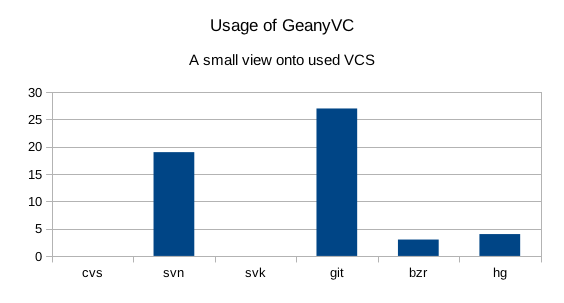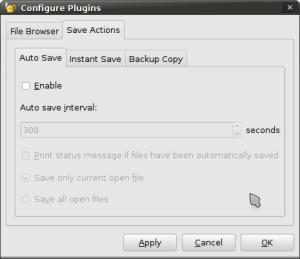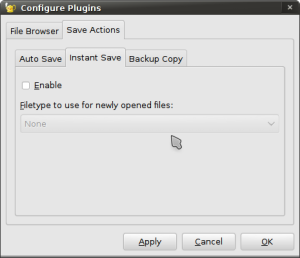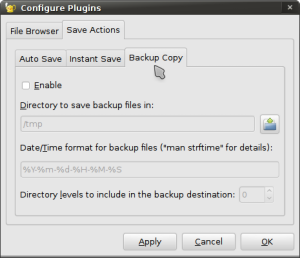Geany Newsletter #2
Contents
About Geany
Geany is a small and lightweight Integrated Development Environment. It was developed to provide a small and fast IDE, which has only a few dependencies from other packages. Another goal was to be as independent as possible from a special Desktop Environment like KDE or GNOME - Geany only requires the GTK2 runtime libraries.
More information about Geany can be found at geany.org.
Geany Development
Update to Scintilla 2.25
With Subversion revision 5682 another update to Scintilla has been done so Geany's development version is now powered by Scintilla 2.25 in favor of the version previously used: 2.22.
As with every update of Scintilla there have been a lot of improvements. This includes changes to Scintilla itself, for example: fixing an issue with marking of a word when double clicking or fixing some memory leaks and unneeded redraws of editor window as well on used lexer e.g. for SQL.
A detailed list of changes done with Scintilla can be found at Scintilla ChangeLog.
Real-time tag parsing
Parsing of symbols (also known as tags) in the file currently being edited can now be done directly in memory. This change means that tag parsing for the current document happens in real time when the content changes; so the symbol list reflects the actual content of the document rather than the state when it was last saved.
This can be configured (and disabled) in the preferences by the Symbol list update frequency option under Editor -> Completions.
Automatic indentation width detection
Geany now has the ability to detect the indentation width used by a file when opening it, making it easier to work with files which use different indentation widths. The auto-detection, however, doesn't yet work if the file uses a tabs-only indentation type.
To enable automatic detection of indentation width, open the Preferences dialog and check Detect width from file in the Editor->Indentation section.
Fixes to template encoding
The encoding of template files is now properly auto-detected, fixing loading of any template using an encoding incompatible with UTF-8.
Plugins
New plugins
geanycfp
Back in January, William Fraser add the geanycfp plugin which adds a couple of interesting new functions to Geany's plugin pool.
After some time this plugin has been split up into GeanyNumberedBookmarks and GeanyMacro, but this process is not yet finished.
GeanyNumberedBookmarks
The plugin adds an option to store bookmarks in files and directly access them via a keybinding.
To set a numbered bookmark press Ctrl+Shift+(a number from 0 to 9). You will see a marker appear next to the line number. If you press Ctrl+Shift+(a number) on a line that already has that bookmark number then it removes the bookmark, otherwise it will move the bookmark there if it was set on a different line, or create it if it had not already been set.
GeanyMacro
Macros are well known from other tools. Users of Photoshop are always saying how amazing the batch processing is for manipulating images. However, this plugin adds something similar to Geany with its macro feature: the plugin can record small actions and rerun them after pressing e.g. a keybinding. This could be very helpful for example if you need to remove the last two letters of a line and search & replace or rectangle selection are not able to solve the request.
Other features
Remembering fold states:
By default, Geany does not remember the status of folding when reloading a file e.g. on startup. This can be annoying when you have a huge number of nested structures e.g. inside an XML-document. This feature helps you to remember those states so you don't have to fold again after loading.
Significant updates on Split Window Plugin
There have been quite a few improvements and bug fixes done in the Split Window plugin that ships with Geany which allows viewing two documents at the same time.
Code folding is now supported in the split editor as of revision 5626.
Since revision 5633, the terminology used in the Split Window menu under the Tools menu has been improved to avoid ambiguity regarding the direction in which the split will take place. Rather than using the word Horizontal for when the editors are laid out horizontally (the splitter is vertical), the words "Side by Side" are now used. Likewise, when the editors are laid out vertically (the splitter is horizontal), the words "Top and Bottom" are now used.
Previously, when the Split Window was active and the document currently being viewed in it was closed in the main documents notebook, the Split Window plugin would unsplit, even if there were other documents which could be viewed instead. As of revision 5634, when this happens, the Split Window plugin will switch to view the current document in the main documents notebook instead. If there are no more documents open, the Split Window plugin will unsplit.
Probably the most significant improvement to the Split Window plugin is that it will now work on Microsoft Windows. Previously, the plugin was using a trick to work around a bug in the Scintilla widget Geany uses as editing component. A side effect of this workaround was that it caused serious issues on Windows and so the plugin was disabled for the Windows build. Matthew Brush fixed the bug in Scintilla and sent the fix to the Scintilla project where it was merged upstream. Geany is no longer required to use the previously mentioned trick, and so the plugin was re-enabled for the Windows build, with equivalent functionality as it has on other platforms.
A view onto GeanyVC usage
GeanyVC is one of the oldest plugins of Geany and adds bindings for some popular version control systems to Geany such as Subversion and GIT. To get a feeling which bindings are being used we started a little Doodle poll a couple of weeks ago. The output was interesting and a little surprising: Until the end of April 2011, 33 people took part in the poll and the first surprise was that none of these are using GeanyVC for working with either CVS or SVK. In terms of CVS this has been a real surprise as it was one of the most popular version control systems during the last decades. SVK always took place a role inside 2nd row as its trying to add some offline functionality to Subversion but keeping Subversion inside core. With the introduction of GIT and a number of new features being added to Subversion with version 1.6, the biggest advantages were also went away.
However, most users do use the plugin for working with GIT (~90%) followed by Subversion as you can see from the tiny chart.

Bazaar and Mercurial are also getting used, but only seem to have a minor role in GeanyVC's universe.
Let us introduce you...
This section is intended to introduce particular plugins or features on a regular basis.
Plugin Focus
Save Actions
The Save Actions plugin adds options available to you when saving files, including: Auto Save, Instant Save and Backup Copy. Each of the options can be enabled independently but they can be even more powerful when used in combination. Read on, discover their functions, and judge for yourself if this plugin might make your use of Geany easier and more productive.
Auto Save

Auto Save provides an option to automatically save either the current file or all open files at a defined interval. It can be very useful if you tend to forget to save because it works in the background. The default interval is 300 seconds, which is 5 minutes, but you might prefer to set a longer or shorter interval.
Instant Save

Instant Save aims to make it easier to make use of Geany's file-specific features with newly-created files. With this plugin activated you can specify what file type new files are to be treated as. If you often work with Python for example, and are testing code snippets, you can activate the plugin, configure new files to be treated as Python and Geany's full Python support is available when the file's created.
Backup Copy

Backup Copy will keep backup copies of files as you save them. Instead of cluttering the file's own directory, the backups are stored in a specific directory. So that you can identify when each backup was created, the backup files have the current date and time added to the end of their names, with the date and time format being configurable. To make finding your backups even easier there is even an option to recreate the directory structure in which the current file is stored.
When combined with the Auto Save option, the Backup Copy option can provide a basic form of versioning with a backup copy of your file(s) every time they were saved. A version control system such as GIT, Subversion or Mercurial is definitely recommended instead when possible.
Feature Focus
Other screen-space-saving tips
Geany has several other options which increase the amount of room available for the editing pane. In the View menu you'll find an option titled "Toggle all Additional Widgets" which hides all elements of the user interface except for the menu bar and scrollbars. Also in the View menu is an option titled "Fullscreen" which maximizes the Geany window to take up the entire screen, also turning off the window's titlebar and borders. This view can be especially useful if you want to minimize distractions from other applications.
Geany local
Geany at Chemnitzer LinuxTage (March, 19th-20th)
Together with the guys of Xfce, Geany was presented with a booth at the annual Chemnitzer LinuxTage event in March, a convention about all topics around Linux, BSD and free software in general. The booth was well visited and people came not only to ask questions or report a bug but also to tell us what they are using Geany for. So Dominic, Enrico and Frank had a lot of questions to answer and a lot of feedback to respond to.
About this newsletter
This newsletter has been created in cooperation by people from Geany's international community. Contributors to this newsletter and the infrastructure behind it, ordered by alphabet:
Colomban Wendling, Dominic Hopf, Enrico Tröger, Frank Lanitz, Matthew Brush, Nicholas Manea, Russell Dickenson

